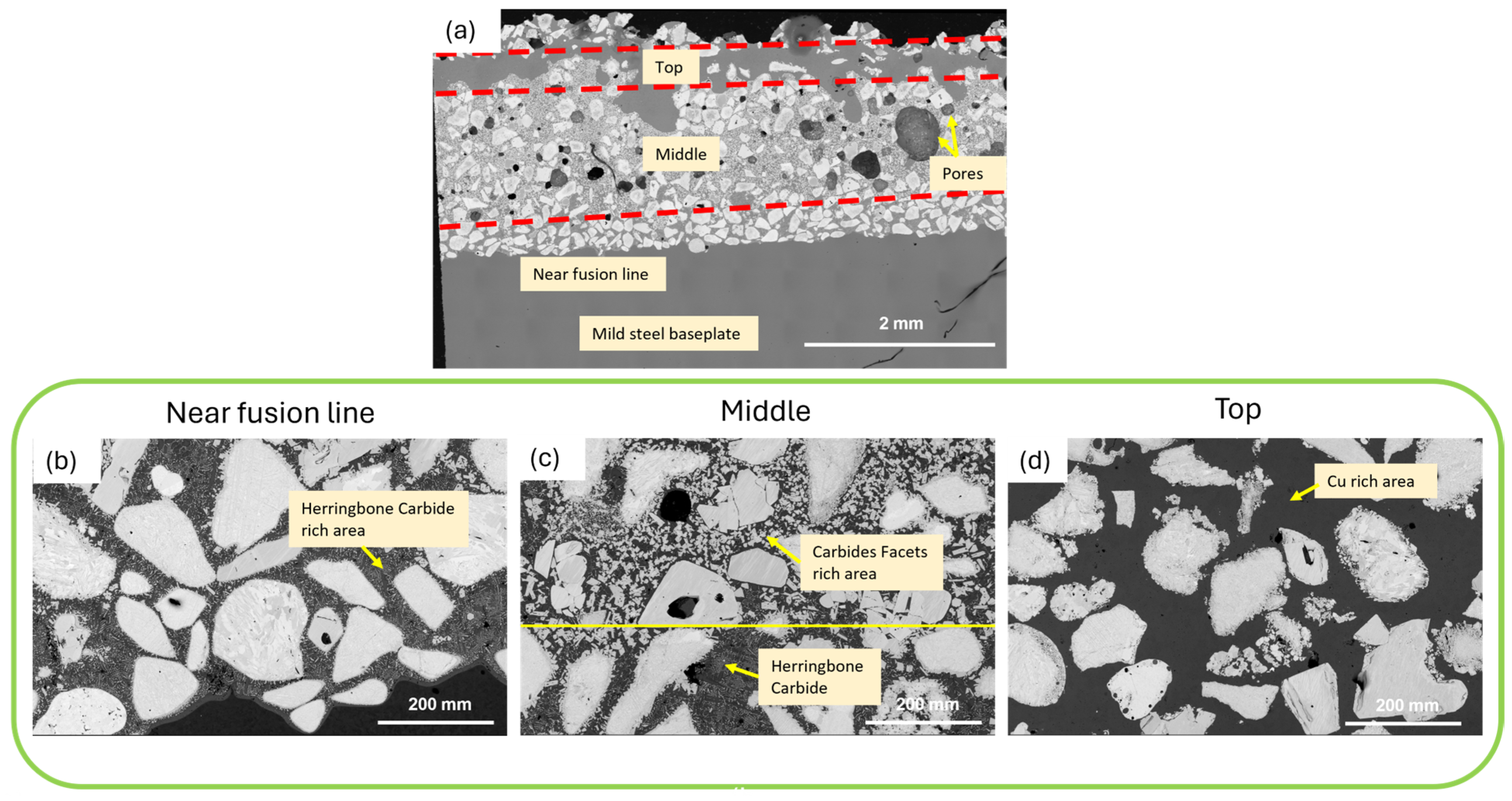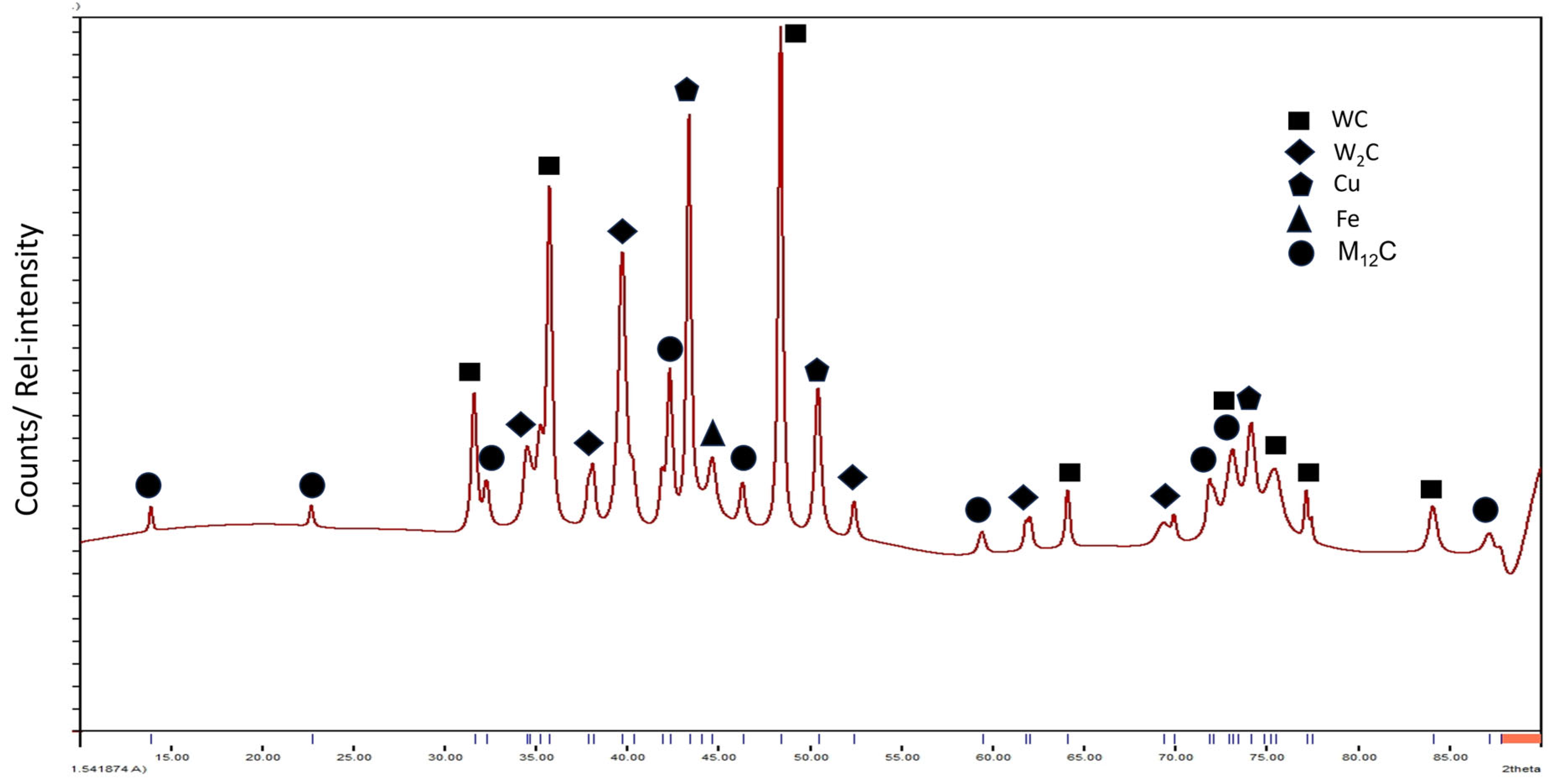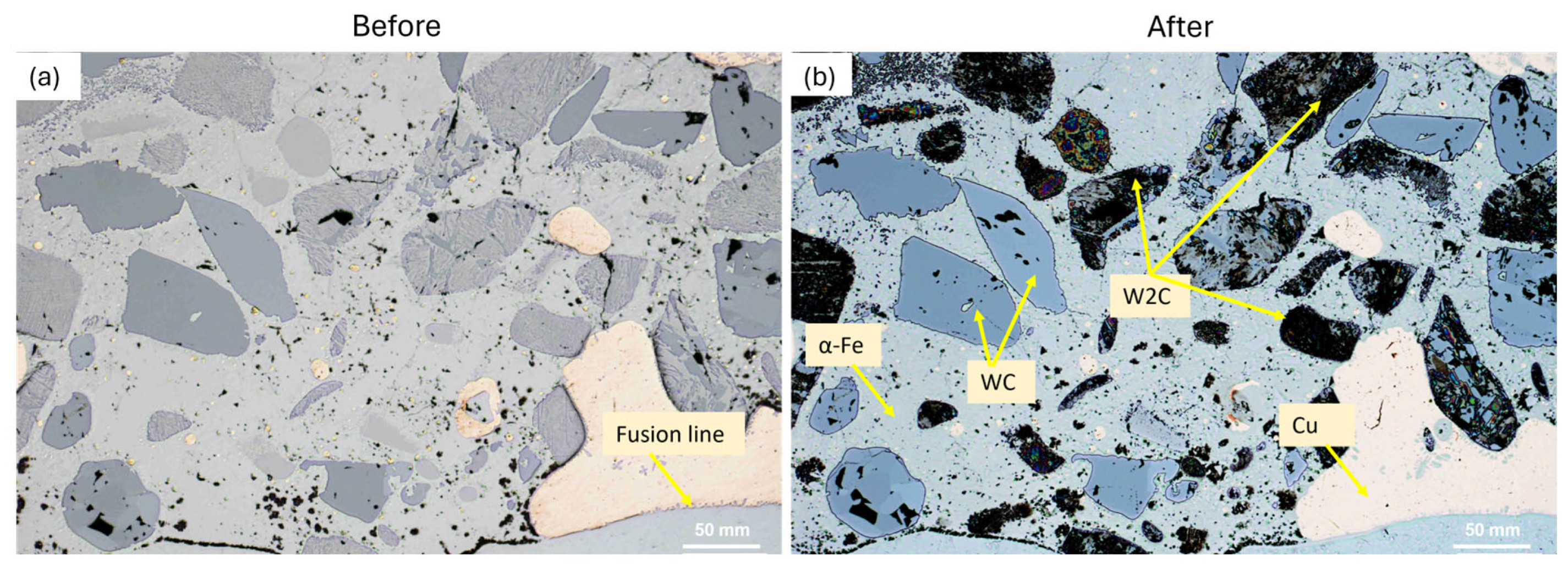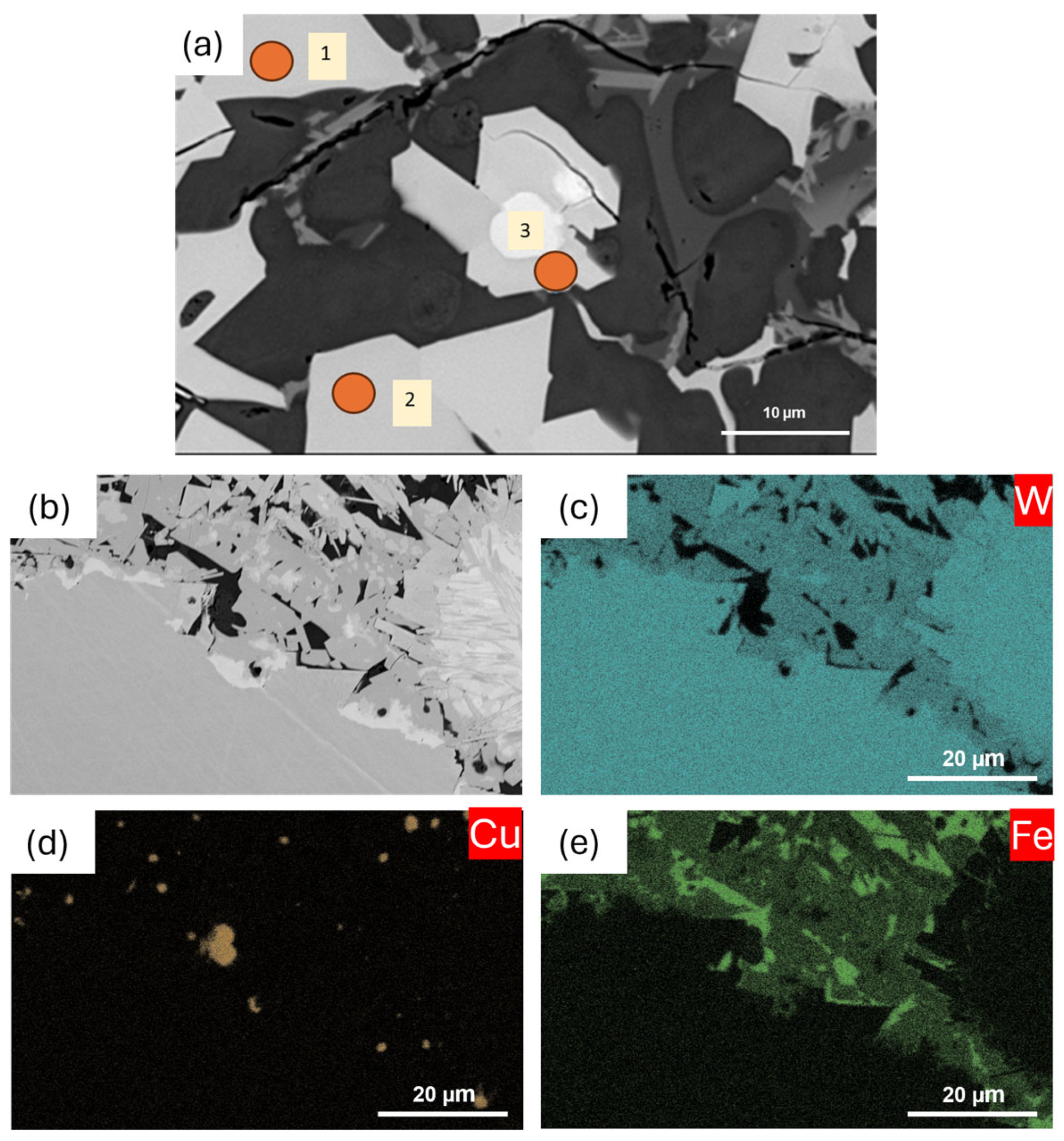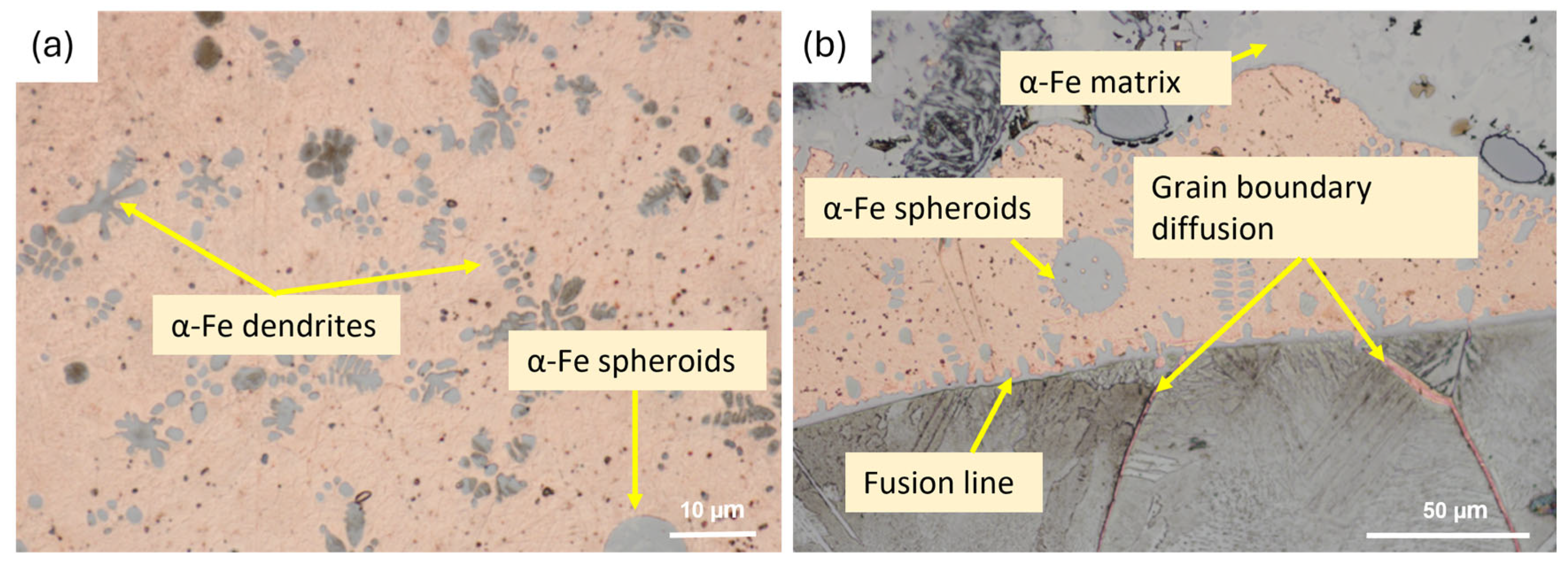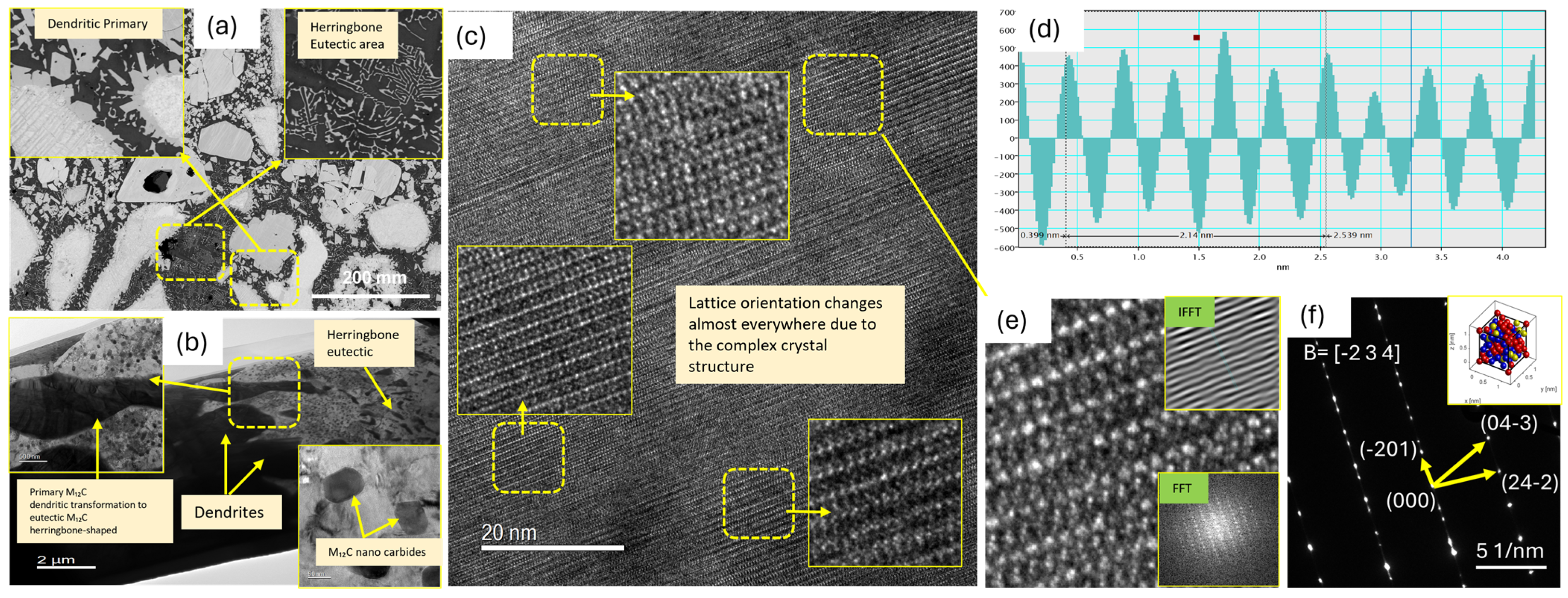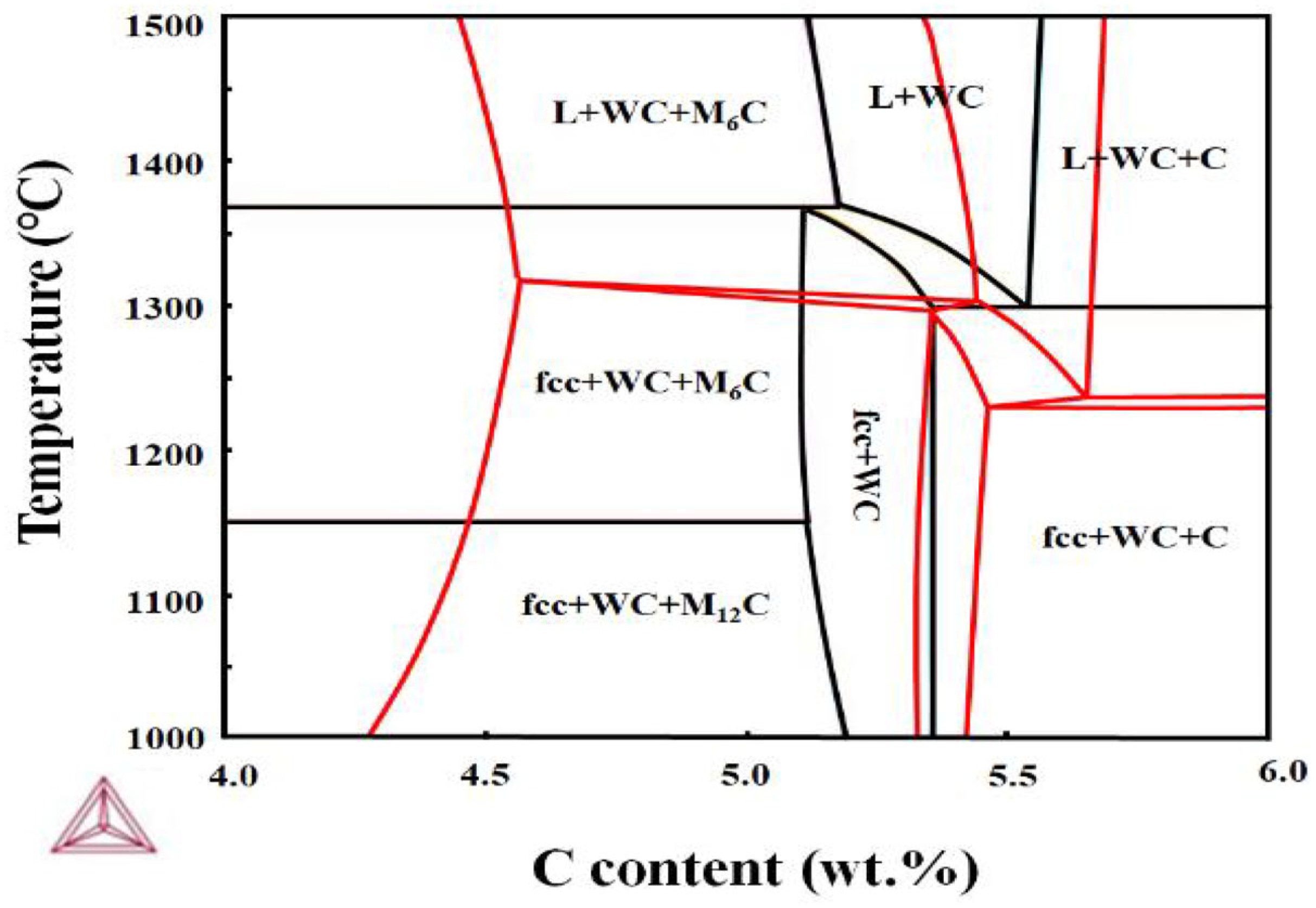1. Introduction
Wear is a critical factor influencing the durability and performance of tools and components in demanding industries such as mining, construction, and steel manufacturing [
1,
2,
3]. Since wear resistance is closely linked to the intrinsic properties of the base metal, enhancing these properties has become a significant research focus. One effective strategy involves the fabrication of metal matrix composites (MMCs), where hard ceramic particles are embedded within a softer metallic matrix to improve surface properties [
4,
5,
6]. The wear resistance of such composites depends on several factors, including the size, shape, type, and volume fraction of the reinforcing particles, as well as the bonding strength between the matrix and reinforcement.
Various hard-facing techniques—such as thermal spraying, coating, and welding—have been utilized to introduce these hard particles onto the surface of base materials [
7,
8,
9]. In applications where both wear resistance and electrical conductivity are required, WC-Cu composites serve as promising candidates, particularly in high-voltage electrical circuits, sliding electric contacts, brake pads and electronic circuit board switches [
10,
11,
12]. Meanwhile, Fe-based substrates are commonly used for current transfer applications such as rail connections [
13,
14]. In these systems, WC enhances resistance against abrasion, impact, and thermal cycling, while the Cu–Fe interface facilitates efficient electrical and thermal conduction. Additionally, the combined presence of Fe and Cu in the matrix enhances toughness by absorbing deformation energy and impeding crack propagation [
15]. Depending upon the amount, size, and morphology of the wear-resistant WC particles, the properties can be tailored to have better conductivity, wear resistance, and mechanical properties in the fabricated composite [
16,
17,
18].
The effectiveness of an MMC is governed by the homogeneity of particle distribution, phase formation, interfacial bonding, and elemental dilution. These microstructural attributes directly influence macroscopic properties such as wear resistance, hardness, strength, and thermal performance [
19,
20,
21].
Plasma transferred arc (PTA) welding is a promising hard-facing technique capable of depositing wear-resistant materials in powder form onto metallic substrates [
5,
6,
22]. It offers numerous advantages, including low cost, high speed, low dilution, precise control overheat input, compatibility with various powder types, and suitability for repair and bulk coating applications [
23,
24,
25]. Among these, control over dilution and interfacial quality is especially crucial, as they significantly impact the coating’s mechanical integrity and conductivity.
In the present study, an attempt to fabricate and optimize the processing parameters for PTA-based hard-facing and composite fabrication was made. Certain input parameters were kept constant, while others were systematically varied based on preliminary trials. This research emphasizes composite layer development and sets the foundation for future study. To the best of our knowledge, this specific approach to WC-Cu composite fabrication via PTA on an iron-based substrate has not been previously reported.
4. Results
4.2. Microstructural Characteristics of WC–Cu Deposition
The microstructure of the WC–Cu composite cladding deposited on a mild steel substrate was systematically characterized at various depths within the clad layer, as illustrated in
Figure 3. Scanning Electron Microscopy (SEM) revealed a heterogeneous microstructure comprising white, angular particles embedded in a matrix of α-Fe, Cu, and intermetallic carbides. The bright contrast in the SEM images corresponds to tungsten-rich phases (WC and W
2C), while darker grey areas represent the softer Cu and Fe matrix.
The WC particles, introduced in their original form via powder feedstock, were found primarily near the fusion line due to their high density relative to Cu. This preferential segregation is consistent with observations in similar systems. The interaction of WC with Fe from the substrate at elevated temperatures during the plasma transferred arc (PTA) process led to partial dissolution and the formation of reaction products, primarily the M12C carbide phase. These carbides manifested in two distinct morphologies: (i) primary M12C, forming as coarse, equiaxed dendritic structures around the periphery of WC particles, and (ii) eutectic M12C, forming as fine herringbone-shaped lamellae along the grain boundaries of α-Fe. The morphology and distribution of these carbides are influenced by local thermal gradients and repeated heating/cooling cycles induced by the PTA.
No pores were detected in the eutectic M
12C region while pores in the primary M
12C phase were more compared to the top Cu rich area as shown in
Figure 3a.
X-ray Diffraction (XRD) analysis, performed on a sample cut from the middle of the composite with a Si specimen holder and a Ni filter to suppress Fe fluorescence, confirmed the presence of WC, W
2C, Cu, and M
12C phases in the composite (
Figure 4). No additional oxide or secondary carbide phases were detected at the top surface. The limited presence of W
2C indicates that only a small fraction of WC underwent decarburization, which is likely inhibited by the rapid cooling facilitated by the high thermal conductivity of Cu. This suggests that most WC particles retained their stoichiometry during deposition.
The observed M
12C phase is thermodynamically favoured in low-carbon environments due to its lower formation energy compared to other carbide types like M
6C or MC. Moreover, M
12C exhibits a more stable lattice with fewer atoms per unit cell (8 for M
12C vs. 16 for M
6C), supporting its preferential formation in the present system [
29]. The presence of herringbone eutectic M
12C was especially prominent near the fusion line, where heat accumulation promotes eutectic transformation, whereas in the mid-cladding regions, M
12C primarily exists as discrete dendritic structures [
30].
Rietveld refinement of the XRD data was performed using HighScore Plus software with reference structures from the PDF-5 database. The refined lattice parameters, summarized in
Table 2, show minor deviations from standard values for WC and W
2C. W
2C has been reported to be stable at room temperature [
31]. These discrepancies are attributed to lattice distortion caused by rapid thermal cycles and possible substitutional dissolution of Fe in the tungsten carbide matrix during solidification. The ternary carbide M
12C exhibited good agreement with standard crystallographic data, suggesting a stable intermetallic structure. The presence of strong single peak at 44.28° shows the presence of preferred single structure [
32]. However, due to the presence of Fe acting as radiation absorber can also lead to minimize the overall intensity of the peaks [
33].
Figure 5a illustrates M
12C morphologies coexisting, while
Figure 5b shows extensive transformation of dendritic M
12C into herringbone structures under increased thermal cycling.
The transformation from WC to W
2C is believed to occur via a decarburization reaction during deposition, as described by the equation [
34]:
The selective etching using a solution of OP-S and NH
3/H
2O
2, provided further contrast between WC and W
2C phases. As shown in
Figure 6, W
2C appears as distinct dark features in the backscattered electron (BSEM) images, confirming that this etching technique selectively reveals W
2C due to its different electrochemical properties [
35].
The WC–Cu composite cladding on mild steel revealed a heterogeneous microstructure with WC and W2C phases concentrated near the fusion line and embedded in an α-Fe/Cu matrix, where partial WC dissolution during PTA processing led to the formation of thermodynamically stable M12C carbides—appearing as both coarse dendrites and fine eutectic herringbone structures—whose identities and distributions were confirmed through SEM, XRD (with Rietveld refinement), EDS, and selective etching, indicating limited WC decarburization, Fe substitution effects, and microstructural evolution driven by thermal cycling.
4.3. Elemental Distribution and EDS Analysis
Energy-Dispersive X-ray Spectroscopy (EDS) analysis was conducted at three distinct regions within the WC–Cu composite coating, as illustrated in
Figure 7. The results reveal an inhomogeneous distribution of Cu, α-Fe, and WC/W
2C particles within the matrix, reflecting the complex thermal and fluid dynamics during deposition.
Near the top surface, WC/W2C particles are predominantly surrounded by the Cu-rich phase. This region exhibits the highest porosity, localized mainly within the Cu matrix, which is consistent with its lower melting point and potential for gas entrapment during solidification. Although the WC/W2C particles are relatively homogeneously dispersed in this zone, the overall particle density is lower than that observed in the middle region. Furthermore, no significant carbide precipitation was detected near the surface, indicating limited interaction between the phases under the rapid cooling conditions at this interface.
The middle region marks a transitional zone characterized by a rapid change in matrix composition from Cu to α-Fe. Here, the formation of M12C carbides is more pronounced, occurring as discrete precipitates within the matrix. This suggests an increased interaction between W and Fe at intermediate depths, influenced by the thermal gradients and diffusion kinetics. Near the fusion line, a narrow Cu-rich band is observed enveloping the WC/W2C and α-Fe matrix. The intensity of carbide precipitation increases with distance from this Cu band, indicating the strong influence of Cu’s high thermal conductivity in moderating the microstructural evolution. The central region of the matrix exhibits the highest carbide density, highlighting the thermal buffering effect of Cu in the adjacent zones.
The elemental distribution within the molten weld pool is significantly affected by fluid flow behaviour. Both density-induced buoyancy forces and Marangoni convection jointly influence the segregation patterns of Fe, W, and Cu during solidification [
36].
Due to its higher density, tungsten (W) tends to settle at the bottom of the weld pool. In contrast, buoyant forces cause Fe and Cu to migrate toward the upper regions. However, Fe exhibits a tendency to nucleate on the surfaces of WC (tungsten carbide) particles, which promotes its retention in WC-rich zones. Copper (Cu), on the other hand, primarily solidifies along the outer edges of the weld bead.
At elevated temperatures, gravitational forces become more dominant than Marangoni convection. This shift occurs because the surface tension of molten Cu decreases with temperature, following this empirical relation [
37]:
This reduction in surface tension allows Cu to float above Fe, while WC particles remain concentrated near the depth of maximum penetration. Additionally, higher heat input can lead to partial evaporation of Cu at the weld bead surface.
Quantitative spot EDS analysis from
Figure 8a in
Table 3 confirms the weight percentages of the carbide phases in agreement with the predicted ranges from phase diagrams [
38]. The analysis also indicates that only a minor fraction of the original WC particles remains unreacted, with the majority undergoing partial or complete melting and subsequent transformation during deposition. Furthermore, the map EDS analysis shown in
Figure 8b–e confirms the relative concentration of Fe atoms into the carbide facets compared with those present as α-Fe.
Considering the Fe–Cu binary phase diagram, the solubility of iron in copper is effectively zero at room temperature. Consequently, liquid–liquid phase separation is a critical phenomenon during solidification, which is reflected in the microstructure exhibiting both dendritic and spheroidal morphologies, as shown in
Figure 9 [
39]. The extent of segregation and miscibility within the Cu–Fe system can be quantitatively described by the composition-composition structure factor, Scc(0), derived from the Gibbs free energy of mixing. The positive Scc(0) values at elevated temperatures indicate a thermodynamic preference for like-atom clustering, leading to segregation into distinct dendritic and spheroidal phases [
40].
At the solidification front of the base metal, a thin molten layer predominantly composed of ferrite forms, serving as an interface between the parent grains and the newly solidified Cu–Fe solid solution. This layer plays a pivotal role in the bonding and microstructural evolution at the coating–substrate interface.
Microstructural analysis reveals a predominance of dendritic iron growth over spheroidal transformation, with only primary dendrites forming due to supercooling effects during solidification. Additionally, grain boundary diffusion of Cu into the base metal has been observed, which may influence interfacial properties and overall coating adhesion.
EDS analysis across the WC–Cu composite cladding revealed depth-dependent inhomogeneity—where surface regions showed Cu-rich matrices with high porosity and limited carbide formation, the midsection exhibited significant M12C carbide precipitation due to enhanced W–Fe interaction, and near the fusion line, Cu’s high thermal conductivity and fluid flow dynamics shaped elemental segregation—with Fe nucleating near WC particles and Cu segregating outward, all governed by buoyancy, Marangoni effects, and solidification thermodynamics, while spot EDS and phase diagram comparisons confirmed partial WC transformation and dendritic iron growth driven by phase separation and grain boundary diffusion.
5. Discussion
The high-temperature plasma transferred arc (PTA) process induces complex metallurgical and thermodynamic phenomena during the deposition of the WC–Cu composite onto a mild steel substrate. The localized melting of both the copper matrix and the iron from the base metal facilitates mutual dissolution and migration, primarily governed by the thermodynamic forces acting on the weld pool. These include Lorentz forces, buoyancy-driven flow, surface tension gradients (Marangoni effects), and arc impingement.
Due to its high melting point, WC remains largely unmelted and is suspended within the molten Cu–Fe matrix. The molten Fe and Cu migrate through lattice diffusion, grain boundary diffusion, or penetrate the base metal via capillary-driven mechanisms. Lattice diffusion involves atom migration into interstitial or substitutional sites, while grain boundary diffusion and penetration allow for faster transport paths due to the lower energy barriers at grain interfaces. This set of mechanisms—especially the migration through boundaries and subsequent absorption into grains—can be broadly described as the irrigation effect of Cu into the base metal.
Once migration occurs, recrystallization is driven by rapid cooling. For dissimilar metal systems such as Cu–Fe, which exhibit immiscibility and zero solid solubility at room temperature, liquid–liquid separation is expected. The resulting microstructure reflects this behaviour, with Cu and Fe segregating into distinct phases during solidification. Dendritic and spheroidal morphologies observed in Fe domains support this, consistent with the positive composition–composition structure factor, Scc(0) indicating preferential segregation of like atoms.
During high-temperature PTA deposition, complex thermodynamic forces—including Lorentz forces, buoyancy, Marangoni effects, and arc impingement—govern the migration and mutual dissolution of molten Cu and Fe into the WC–Cu composite, while WC remains largely unmelted, and subsequent lattice and grain boundary diffusion (irrigation effect) followed by rapid cooling induces recrystallization and liquid–liquid phase separation, producing distinct Cu and Fe segregation with dendritic and spheroidal Fe morphologies along with M12C.
It is important to note that the present study was conducted using a single-layer cladding on a mild steel substrate. The deposition of cladding on alternative substrate materials, or the fabrication of multilayer composite coatings, would require adjustment of welding parameters. This necessity arises from the markedly higher thermal conductivities of copper (Cu) and tungsten carbide (WC) compared to mild steel, which significantly affect melt pool formation and solidification dynamics. Furthermore, in the case of multilayer deposition, it is feasible to obtain a relatively pure composite region comprising only WC and Cu, provided that optimal process parameters are identified and applied.
Author Contributions
M.H., conceptualization, methodology, investigation, data analysis, and writing and editing—original draft; B.D., resources, data validation, data curation, methodology, review, and editing; Z.Q., external supervision, review and editing, project administration, external funding acquisition, and resources; U.G., project administration, resources, visualization, external funding acquisition, external supervision, and resources; Z.P., conceptualization, investigation, supervision, and project administration; H.L., conceptualization, investigation, supervision, and project administration. All authors have read and agreed to the published version of the manuscript.
Funding
This study was supported by the Australian Nuclear Science and Technology Organization–University of Wollongong Joint Project Seed Funding.
Data Availability Statement
The original contributions presented in this study are included in the article. Further inquiries can be directed to the corresponding author.
Conflicts of Interest
The authors declare that they have no known competing financial interests or personal relationships that could have appeared to influence the study reported in this paper.
Abbreviations
| PTA | Plasma Transferred Arc |
| MMCs | Metal Matrix Composites |
| XRD | X-ray Diffraction |
| SEM | Scanning Electron Microscopy |
| EDM | Electrical Discharge Machining |
| FIB | Focused Ion Beam |
| TEM | Transmission Electron Microscopy |
| SAED | Selected Area Electron Diffraction |
| M12C | Fe6W6C |
| M6C | Fe3W3C |
| BSEM | Backscattered Electron Microscopy |
| CIF | Crystallographic Information File |
| HRTEM | High-Resolution Transmission Electron Microscopy |
| FFT | Fast Fourier Transform |
| IFFT | Inverse Fast Fourier Transform |
| G/R | Temperature Gradient to Solidification Rate Ratio |
References
- Holmberg, K.; Kivikytö-Reponen, P.; Härkisaari, P.; Valtonen, K.; Erdemir, A. Global energy consumption due to friction and wear in the mining industry. Tribol. Int. 2017, 115, 116–139. [Google Scholar] [CrossRef]
- Buchely, M.; Gutierrez, J.; Leon, L.; Toro, A. The effect of microstructure on abrasive wear of hardfacing alloys. Wear 2005, 259, 52–61. [Google Scholar] [CrossRef]
- Appiah, A.N.S.; Bialas, O.; Żuk, M.; Czupryński, A.; Sasu, D.K.; Adamiak, M. Hardfacing of mild steel with wear-resistant Ni-based powders containing tungsten carbide particles using powder plasma transferred arc welding technology. Mater. Sci.-Pol. 2022, 40, 42–63. [Google Scholar] [CrossRef]
- Leech, P.W.; Li, X.S.; Alam, N. Comparison of abrasive wear of a complex high alloy hardfacing deposit and WC–Ni based metal matrix composite. Wear 2012, 294, 380–386. [Google Scholar] [CrossRef]
- Prabanjan, S.; Karthick, K.; Rejvin Kumar, J.; Ramkumar, S.; Riswan Ahmed, A. Wear behavior and metallurgical characteristics of particle reinforced metal matrix composites produced by hardfacing: A review. Mater. Today Proc. 2020, 33, 599–606. [Google Scholar] [CrossRef]
- Aoh, J.-N.; Chen, J.-C. On the wear characteristics of cobalt-based hardfacing layer after thermal fatigue and oxidation. Wear 2001, 250, 611–620. [Google Scholar] [CrossRef]
- Mao, L.; Cai, M.; Liu, Q.; Han, L. Effects of spherical WC powders on the erosion behavior of WC-Ni hardfacing used for steel body drill bit. Surf. Coat. Technol. 2021, 409, 126893. [Google Scholar] [CrossRef]
- Pintsuk, G.; Smid, I.; Döring, J.-E.; Hohenauer, W.; Linke, J. Fabrication and characterization of vacuum plasma sprayed W/Cu-composites for extreme thermal conditions. J. Mater. Sci. 2007, 42, 30–39. [Google Scholar] [CrossRef]
- Deng, N.; Tang, J.; Xiong, T.; Li, J.; Zhou, Z. Fabrication and characterization of WCu composite coatings with different W contents by cold spraying. Surf. Coat. Technol. 2019, 368, 8–14. [Google Scholar] [CrossRef]
- Zhou, Y.X.; Xue, Y.L.; Zhou, K. Failure analysis of arc ablated tungsten-copper electrical contacts. Vacuum 2019, 164, 390–395. [Google Scholar] [CrossRef]
- Tungsten-Copper for Use in Circuit Breakers. Available online: https://www.plansee.com/en/products/wcu-switching-contacts.html (accessed on 5 August 2024).
- Xiao, Y.; Zhang, Z.; Yao, P.; Fan, K.; Zhou, H.; Gong, T.; Zhao, L.; Deng, M. Mechanical and tribological behaviors of copper metal matrix composites for brake pads used in high-speed trains. Tribol. Int. 2018, 119, 585–592. [Google Scholar] [CrossRef]
- Wang, Y.; Luo, J.; Wang, X.; Xu, X. Interfacial characterization of T3 copper/35CrMnSi steel dissimilar metal joints by inertia radial friction welding. Int. J. Adv. Manuf. Technol. 2013, 68, 1479–1490. [Google Scholar] [CrossRef]
- Zhao, X.; Lu, X.; Wang, K.; He, F. Investigation on the Microstructure and Mechanical Properties of Stud Welded Joints of Cu/304 Austenitic Stainless Steel under Different Welding Voltages. J. Mater. Eng. Perform. 2023, 32, 613–623. [Google Scholar] [CrossRef]
- Bai, H.; Kang, L.; Zhuang, W.; Liu, J.; Zhong, L.; Xu, Y. Microstructure and mechanical properties of W-WC/Fe composite fiber-reinforced Fe matrix composite prepared by combination of infiltration and in-situ solid phase diffusion. J. Mater. Res. Technol. 2023, 27, 5305–5314. [Google Scholar] [CrossRef]
- Zhao, Z.; Liu, J.; Tang, H.; Ma, X.; Zhao, W. Investigation on the mechanical properties of WC–Fe–Cu hard alloys. J. Alloys Compd. 2015, 632, 729–734. [Google Scholar] [CrossRef]
- Shi, H.; Duan, L.; Tan, S.; Fang, X. Influence of pre-alloying on Fe-Cu based metal matrix composite. J. Alloys Compd. 2021, 868, 159134. [Google Scholar] [CrossRef]
- Zhai, K.; Chen, S.; Wang, C.; Li, Q.; Sun, B.; He, J. Microstructure and properties of WC-CoCuFeNi composites fabricated by spark plasma sintering. Int. J. Refract. Met. Hard Mater. 2022, 105, 105808. [Google Scholar] [CrossRef]
- Tejado, E.; Müller, A.v.; You, J.H.; Pastor, J.Y. The thermo-mechanical behaviour of W-Cu metal matrix composites for fusion heat sink applications: The influence of the Cu content. J. Nucl. Mater. 2018, 498, 468–475. [Google Scholar] [CrossRef]
- Zhang, H.; Liu, J.-R.; Zhang, G.-H. Preparation and properties of W-30 wt% Cu alloy with the additions of Ni and Fe elements. J. Alloys Compd. 2022, 928, 167040. [Google Scholar] [CrossRef]
- Han, T.; Hou, C.; Zhao, Z.; Jiao, Z.; Li, Y.; Jiang, S.; Lu, H.; Wang, H.; Liu, X.; Nie, Z.; et al. Simultaneous enhancement of strength and conductivity via self-assembled lamellar architecture. Nat. Commun. 2024, 15, 1863. [Google Scholar] [CrossRef]
- Balasubramanian, V.; Lakshminarayanan, A.K.; Varahamoorthy, R.; Babu, S. Application of Response Surface Methodolody to Prediction of Dilution in Plasma Transferred Arc Hardfacing of Stainless Steel on Carbon Steel. J. Iron Steel Res. Int. 2009, 16, 44–53. [Google Scholar] [CrossRef]
- Łatka, L.; Biskup, P. Development in PTA surface modifications—A review. Adv. Mater. Sci. 2020, 20, 39–53. [Google Scholar] [CrossRef]
- Takano, E.H.; de Queiroz, D.; D’Oliveira, A.S.C.M. Evaluation of processing parameters on PTA hardfacing surfaces. Weld. Int. 2010, 24, 241–248. [Google Scholar] [CrossRef]
- Lakshminarayanan, A.K.; Balasubramanian, V.; Varahamoorthy, R.; Babu, S. Predicting the dilution of plasma transferred arc hardfacing of stellite on carbon steel using response surface methodology. Met. Mater. Int. 2008, 14, 779–789. [Google Scholar] [CrossRef]
- ASTM E3-11; Standard Guide for Preparation of Metallographic Specimens. ASTM International: West Conshohocken, PA, USA, 2017.
- ASTM E1508; Standard Guide for Quantitative Analysis by Energy-Dispersive Spectroscopy. ASTM International: West Conshohocken, PA, USA, 2019.
- ASTM-E3294-22; Standard Guide for Forensic Analysis of Geological Materials by Powder X-Ray Diffraction. ASTM International: West Conshohocken, PA, USA, 2022.
- Suetin, D.V.; Shein, I.R.; Ivanovskii, A.L. Structural, electronic and magnetic properties of η carbides (Fe3W3C, Fe6W6C, Co3W3C and Co6W6C) from first principles calculations. Phys. B: Condens. Matter 2009, 404, 3544–3549. [Google Scholar] [CrossRef]
- Zhang, J.; Jia, H.; Ge, S.; Wei, Q.; Luo, G.; Shen, Q. Porous tungsten synthesized via dealloying: Fe6W6C induced structure modification and mechanical behavior. J. Alloys Compd. 2023, 947, 169708. [Google Scholar] [CrossRef]
- Luo, N.; Hou, Z.; Lin, C.; Chai, G.-L. Toward a Unified Understanding of W2C Polymorphic Structures by First-Principles Calculations. Cryst. Growth Des. 2023, 23, 5486–5497. [Google Scholar] [CrossRef]
- Dadashi, S.; Poursalehi, R.; Delavari, H. Structural and Optical Properties of Pure Iron and Iron Oxide Nanoparticles Prepared via Pulsed Nd:YAG Laser Ablation in Liquid. Procedia Mater. Sci. 2015, 11, 722–726. [Google Scholar] [CrossRef]
- Shakunt, N.S.; Gouthama; Upadhyaya, A. Effect of Fe addition in W-Ni-Cu heavy alloy processed through powder metallurgy on microstructure and mechanical properties. J. Alloys Compd. 2024, 970, 172578. [Google Scholar] [CrossRef]
- Cheniti, B.; Miroud, D.; Hvizdoš, P.; Balko, J.; Sedlák, R.; Csanádi, T.; Belkessa, B.; Fides, M. Investigation of WC decarburization effect on the microstructure and wear behavior of WC-Ni hardfacing under dry and alkaline wet conditions. Mater. Chem. Phys. 2018, 208, 237–247. [Google Scholar] [CrossRef]
- Mühlbauer, G.; Kremser, G.; Bock, A.; Weidow, J.; Schubert, W.-D. Transition of W2C to WC during carburization of tungsten metal powder. Int. J. Refract. Met. Hard Mater. 2018, 72, 141–148. [Google Scholar] [CrossRef]
- Hussain, M.; Dong, B.; Qiu, Z.; Garbe, U.; Pan, Z.; Li, H. A Review on the Additive Manufacturing of W-Cu Composites. Metals 2025, 15, 197. [Google Scholar] [CrossRef]
- Su, S.; Lu, Y. Densified WCu composite fabricated via laser additive manufacturing. Int. J. Refract. Met. Hard Mater. 2020, 87, 105122. [Google Scholar] [CrossRef]
- Li, X.; Zhang, J.; Zhang, Q.; Zhang, X.; Ji, V.; Liu, J. Microstructure Evolution and Hardness Improvement of WC-Co Composites Sintered with Fe Substituting Part of Co Binder. Coatings 2023, 13, 116. [Google Scholar] [CrossRef]
- Huang, S.; Lin, B.; Niu, W.; Wang, G.; Li, J. Study on the microstructure evolution and mechanical properties of spray-forming Cu-Fe alloys with varying Fe compositions. J. Alloys Compd. 2025, 1013, 178452. [Google Scholar] [CrossRef]
- Liu, S.; Jie, J.; Guo, Z.; Yin, G.; Wang, T.; Li, T. Solidification microstructure evolution and its corresponding mechanism of metastable immiscible Cu80Fe20 alloy with different cooling conditions. J. Alloys Compd. 2018, 742, 99–106. [Google Scholar] [CrossRef]
Figure 1.
(a) SEM morphology of the WC and Cu; (b) XRD map of the powder.
Figure 2.
(a) PTA schematic, (b) single bead, and (c) multiple single-pass coatings.
Figure 3.
Microstructure of the composite cladding showing a (a) cross-section of the cladding, (b) near the fusion line, (c) the middle region, and (d) the top region.
Figure 4.
XRD analysis of the composite cladding.
Figure 5.
Conversion from (a) facets to (b) herringbone-shaped M12C carbides.
Figure 6.
WC/W2C particles before and after final polishing with OPS+: (a) without NH3/H2O2 and (b) with NH3/H2O2.
Figure 7.
EDS elemental mapping of the composite at different regions: (a–d) top, (e–h) middle, and (i–l) near the fusion zone, showing spatial variations in W, Cu, and Fe distribution.
Figure 8.
(a) Spot EDS analysis for ternary carbides and (b–e) map EDS analysis.
Figure 9.
Microstructure at the (a) top, and (b) near the fusion line showing the spheroidal, dendritic growth of Fe with grain boundary diffusion.
Figure 10.
TEM analysis of the intermetallic phase (a) The dendritic and herringbone structure, (b) conversion of the primary M12C dendritic structure into a herringbone structure, (c) selected area HRTEM showing different crystallographic lattice orientations, (d) lattice spacing calculation using Gatan, (e) selected area crystallographic orientation and its relevant FFT and IFFT images, (f) and TEM diffraction indexed pattern.
Figure 11.
WC transformation into M6C and M12C.
Table 1.
Parameters used for deposition.
| Sr # | Shielding Gas Flow Rate (L/min) | Plasma Gas Flow Rate (L/min) | Shielding Gas Flow for Shielding Hood (L/min) | Powder Feed Rate (g/min) | Current (A) | Travel Speed
(mm/s) | Stand-Off Distance (mm) | Powder Flow Gas (L/min) | % Overlapping | Thickness of the Cladding (mm) |
|---|
| 1 | 15 | 1.5 | 3.5 | 15.34 | 125 | 2.67 | 12 | 2 | 30 | 1.9 |
Table 2.
Refined structural parameters of the composite using X-ray diffraction.
| Component | Lattice Parameters (Å)
Dilution | Rp/Rwp % | Crystallite Size (nm) | Space Group |
|---|
| Dilution |
|---|
| WC | a = 2.907
b = 2.907
c = 2.835 | 5.51/6.5 | 289.9 | P −6 m 2 |
| W2C | a = 2.995
b = 2.995
c = 4.728 | 244.3 | P −3 m 1 |
| Cu | a = 3.617
b = 3.617
c = 3.617 | 584.1 | Fmm |
| Fe | a = 2.875
b = 2.875
c = 2.875 | 241.8 | Imm |
| M12C (Fe6W6C) | a = 11.116
b = 11.116
c = 11.116 | 201 | F d −3 |
Table 3.
Point EDS analysis at three points of the intermetallic phase showing the wt.% of the individual elements.
| EDS Point | Fe [wt.%] | W [wt.%] | C [wt.%] |
|---|
| 1 | 24.000 | 70.600 | 5.4 |
| 2 | 23.300 | 71.500 | 5.2 |
| 3 | 23.300 | 71.500 | 5.2 |
| Disclaimer/Publisher’s Note: The statements, opinions and data contained in all publications are solely those of the individual author(s) and contributor(s) and not of MDPI and/or the editor(s). MDPI and/or the editor(s) disclaim responsibility for any injury to people or property resulting from any ideas, methods, instructions or products referred to in the content. |
© 2025 by the authors. Licensee MDPI, Basel, Switzerland. This article is an open access article distributed under the terms and conditions of the Creative Commons Attribution (CC BY) license (https://creativecommons.org/licenses/by/4.0/).


